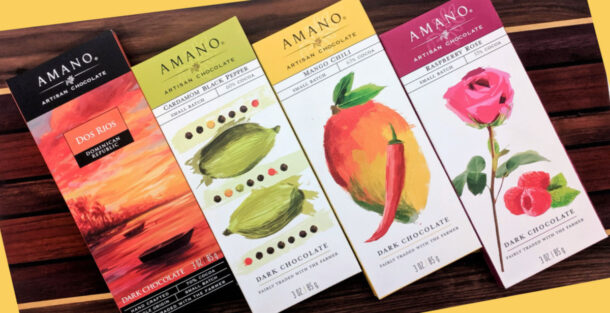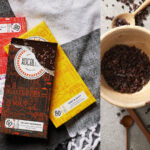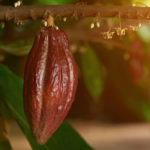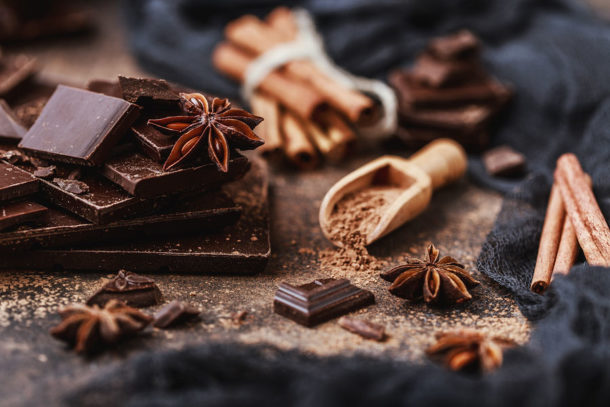FAIR TRADE, FAIR CHOCOLATE
by Amy Peterson & Eric Battersby
If you’ve ever purchased a high quality chocolate bar at any health food store, from smaller retailers all the way up to the market giant, Whole Foods, then you’re likely familiar with the labels “USDA Organic” and “Fair Trade”. Many higher end chocolate bars proudly display both these labels on their wrappers, but what exactly defines Organic and Fair Trade, and are there any real product benefits inherent to these labels?
It’s important to understand that not all fair Trade is organic, not all organic is fair trade, many are neither, and some are both. Crystal clear, right? No worries though, let’s drill down to the bottom of Fair Trade and Organic certifications together.
First of all, what exactly is Fair Trade? The most popular label you’ll see on products if you live here in the United States is the Fair Trade USA, or FTA, label (see both the old and new labels, pictured below). FTA is a not-for-profit 501(c)3 organization that certifies products as Fair Trade for companies. The big question, which unfortunately ballooned to an even bigger question over the past few years, is how do products actually qualify as fair trade?
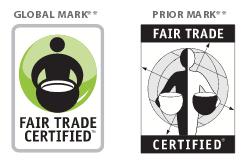
The FTA investigates and certifies business transactions between U.S. companies and their suppliers – suppliers who are often in under-developed countries. In a perfect world, this ensures that suppliers receive fair pay and work in safe environments. It also restricts the use of pesticides and fertilizers and prohibits GMOs (genetically modified organisms), in order to protect farmers’ health and maintain the ecosystem.
Through the Fair Trade program, farmers and business owners also gain an understanding of how the global market works, an important part of the program. Fair Trade benefits more than 1.2 million farmers and their families in 70 countries, from different regions around the world including Africa, Asia and Latin America.
So the principals of Fair Trade are fair prices, sustainable wages and better living conditions, but this also includes a guarantee that children will never be forced into slave labor. There should be direct trade between the producers and the importers as well, eliminating any need for a middleman. Funds from fair trade sales are set aside to improve local communities via programs such as leadership training, quality of life improvement, healthcare, scholarships, school development, organic certification, environmental protection and women’s rights.
In the past couple of years, however, Fair Trade certification has turned all too ambiguous, particularly within Fair Trade USA. More on that unusual development in a moment, but first, let’s delve into organics.
Does a Fair Trade label inherently mean that a product is also organic? No, not necessarily. Although Fair Trade USA claims to promote organic products, you can’t assume that any Fair Trade USA certified products are also organic by default. Right now, if a product is FTA certified, you can be fairly confident in at least a restriction of fertilizer and pesticide use, that no GMOs are contained in the product, that the water and waste are properly managed in production areas, and that natural vegetation and water resources are protected. That is, however, as far as any fair trade designation will go on the organic front.
In the United States, many different products are now certified organic, including coffee and teas, herbs, cocoa, spices, sugar, fruits, vegetables, nuts, oils, butter, beans, grains, flowers and honey. If you’re curious and would like to read up on the complete standards for the USDA Organic certification, you can check out the official USDA page for details (http://1.usa.gov/16pJNdu), and this PDF focuses specifically labeling. Here’s a quick summary, however, so you’re up-to-speed on the basics.

For crops, “The USDA organic seal verifies that irradiation, sewage sludge, synthetic fertilizers, prohibited pesticides, and genetically modified organisms were not used.” For multi-ingredient foods, one of the most popular uses today (including chocolate bars), the USDA Organic certification “verifies that the product has 95% or more certified organic content. If the label claims that it was made with specified organic ingredients, you can be sure that those specific ingredients are certified organic.”
And all of this falls under one protective umbrella so to speak: “Overall, organic operations must demonstrate that they are protecting natural resources, conserving biodiversity, and using only approved substances.” So a product only labeled as Fair Trade is certainly missing a key part of the equation when it’s not also labeled organic, and a product labeled as Organic may also be missing part of the equation when it’s not labeled Fair Trade as well – particularly if some of the product ingredients are sourced from underdeveloped countries.
With all of that in mind, let’s get to the fun part… chocolate! It wasn’t easy, but I forced myself to try many, many different Organic and Fair Trade certified chocolate bars in order to bring you these three favorites. I trust that all of my sacrifice and effort will not go in vain (seriously, I love writing for a chocolate magazine)! And regarding the Fair Trade issue I mentioned earlier, that information is coming… but let’s take a peek at these chocolate bars first.
1. THEO CHOCOLATES SALTED ALMOND BAR
Theo Chocolates are made in Seattle, Washington, and they make some seriously amazing chocolate bars. This Salted Almond Bar, 70% dark chocolate, earns high marks as my personal favorite. The bar delivers a nice smooth texture that melts in your mouth, with just the perfect amount of crunch provided by the crushed almonds. Absolutely delicious!
Theo Chocolates takes Fair Trade and Organic quite seriously. All their bars are not only Fair Trade and USDA Organic certified, but also Non-GMO Project Verified as well. In fact, as they tout on their website, Theo Chocolates are “proud to be the first Organic and Fair Trade fair for Life Bean-to-Bar Chocolate Factory in North America.” We featured their Single Malt Scotch Ganache Collection in our February issue’s Chocolate Shop, and Theo Chocolates receive our highest recommendation.
https://www.theochocolate.com/
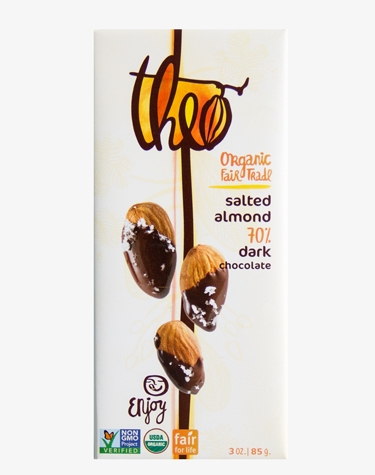

2. EQUAL EXCHANGE 71% VERY DARK CHOCOLATE BAR
Easily another of my all time favorite bars, this outstanding creation comes to us from Equal Exchange Chocolates. The 71% dark chocolate bar is super smooth, with no bitterness. I do generally prefer dark chocolate, however, so a milk chocolate-centric person may disagree with that analysis.
Equal Exchange also produces an Organic Dark Chocolate With Almonds Bar that has a 55% cacao content, and is therefore less bitter, but still not too sweet. If the 71% dark isn’t your thing, I recommend starting off with the 55% bar instead. On a final note, Equal Exchange crafts their chocolate bars in West Bridgewater, Massachusetts, and all of their chocolate bars are both Fair Trade and Organic certified.
http://shop.equalexchange.coop/
3. GREEN & BLACK’S ORGANIC MILK CHOCOLATE TOFFEE
Rounding out my Top 3 Favorites List is the Milk Chocolate Toffee Bar from Green & Black’s Organic. This bar is simply outstanding. Its creamy texture and smooth finish, combined with little bits of toffee mixed into the bar, offer an amazing chocolate experience. The bar contains only 34% cocoa content, so it’s not really the chocolate you eat for health benefits – but definitely for the yummy benefits! Green & Black’s Organics create their bars in Italy and distribute in the United States out of Parsippany, New Jersey. All of their chocolate bars are both Fair Trade and Organic certified.
http://www.greenandblacksdirect.com
Although I highly recommend the three bars mentioned above, I also strongly encourage you to go out and perform your own taste tests. Yes, these bars are more expensive than your normal grocery or drugstore bar, but they are made with natural ingredients you can pronounce, don’t contain any preservatives, are helping underdeveloped countries become self sufficient, and are better for the environment. That’s a winning combination for everyone.”

Now for the final word on Fair Trade, as I hinted at earlier. Fair Trade USA drew the ire of many fair trade advocates back in late 2011 when it unveiled new, and lower, fair trade standards. In fact, on October 19, 2011, the Fair World Project put out a rather scathing press release on the FTA’s new agenda, which they largely perceived as catering to larger companies while also undermining the entire fair trade philosophy.
You can read the press release here in its entirety (http://bit.ly/10AYfed), but this snippet is perhaps the most chilling point of the entire text:
“…under the new FTUSA labeling standards, a “fair trade” chocolate bar could in fact contain sugar, vanilla or cocoa produced using child or forced labor, even though all these ingredients are commercially available in fair trade form.”
Indeed, the current standards allow companies to use a Fair Trade label that looks almost identical to a fully certified product, when instead only as little as 20% of that product’s ingredients are actually Fair Trade certified. For the other 80%, well… let’s just say you’ll really want to start reading your labels.
Thankfully there are organizations like this one, FairTrade International (FLO), and their up-and-coming counterpart, FairTrade America (or FairTrade International USA). Here’s a link to the FairTrade America website, where you can learn more about the work they’re doing to keep the philosophy of fair trade alive and well: http://fairtradeamerica.org/
So the bottom line on Fair Trade certification is that you’ll likely see more and more designations of fair trade in the generic sense (Equal Exchange is already a prime example), and if you’re really trying to be socially conscious, you’ll simply need to read your labels more closely. Plus, the FTUSA label still holds up, you just need to look for the 100% certification label, instead of the 20% version that’s been popping up on more and more products.
I will admit, it always feels uplifting to indulge in a little chocolate, but it feels even moreso when I know I’m supporting a better world while doing so. If you feel the same way, take a moment next time you’re enjoying your favorite Organic and Fair Trade Chocolate Bar, and think about the good that chocolate is bringing to those who produce it. Your next bite may taste even better.







